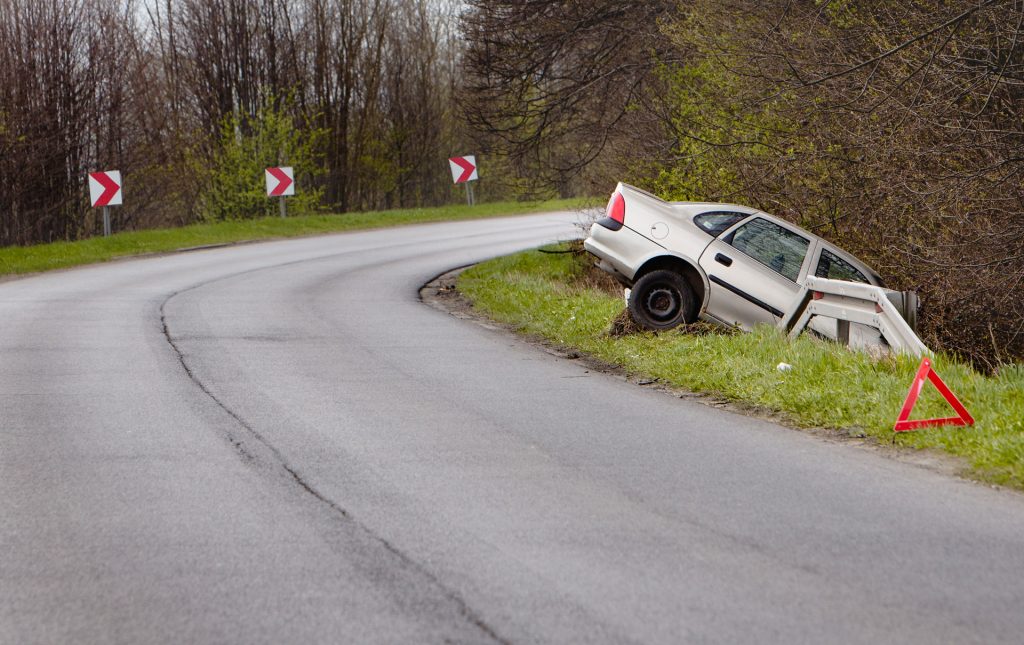Wheels-Off Road Recovery
In icy or stormy conditions, or even when people have been speeding or not paying attention to the road, drivers outside the city and even in urban areas are likely to see vehicles in the ditches or perched on top of boulevards. Going off the road can be very easy in bad weather, but it can happen even in reasonably good conditions when rain or snow are not factors in safety. Whatever the reason for the wheels going off the road, drivers should know how to recover so that they can safely continue on their way.
A vehicle’s wheels can go off the road for many reasons. Sometimes the driver is not paying enough attention to staying in the centre of the lane, or a sudden strong gust of wind may startle the driver into losing control of the steering wheel for a few moments. In many cases, drivers can recover quite easily without any significant issues. When any of the wheels leave the pavement, however, they will need to know how to recover from this potentially dangerous situation.
The First Steps for Returning to the Road
The Government of Ontario’s Driver’s Handbook includes recommendations for drivers who have the experience of the wheels of their vehicle going off the road. The first point is to avoid panic. Feeling a loss of control as the vehicle slides off the road can cause drivers to be alarmed and possibly to make serious mistakes as they attempt to get the vehicle back on the road.
In some cases, drivers may completely lose control of their vehicles and end up crashing into something at the side of the road, possibly causing injuries or major damages. In the stress of dealing with traffic and everything they must remember, drivers can become overwhelmed and be unable to think. However, staying calm can help drivers to remember the techniques that they have learned for dealing with situations like these.
Although some drivers tend to panic more easily than others, everyone should have a basic plan for what to do in case of an emergency. Thinking through potential problem situations before they happen can help drivers to develop helpful automatic responses to the situations they encounter. This kind of automatic response is especially helpful in situations that can be dangerous, such as when a vehicle’s wheels run off the road.
Staying calm on the road may be easier in theory than in practice. However, drivers can learn techniques for remaining calm, as Lisa Monforton notes in her August 2014 Globe and Mail article. For example, it is important for drivers to leave enough time to get to their destinations. Rushing to get somewhere at the last minute can be stressful and can increase the likelihood of an accident due to inattention.
Leaving enough time for possible contingencies is especially important in icy or wet weather. Rushing to get to a destination when the road has icy patches, for example, can result in more serious accidents than if drivers move at a steady pace. Being in a rush can take people’s attention away from the task of driving, which can have deadly results in icy or wet conditions. If the wheels of the vehicle go off the road, the driver will have less time to react at higher speeds than at lower speeds.
Avoiding Conflict
Avoiding conflicts with other drivers is important for staying calm, according to Monforton. Sometimes, an angry driver may follow another vehicle and possibly try to attack another road user, or they may shout or gesture angrily.
An angry response from another road user can distract a driver from the necessity of watching their actions. On the road, drivers should pay attention to the task of operating a vehicle, including watching for traffic, cyclists and pedestrians, besides operating signal lights, windshield wipers and other features of the vehicle. When a vehicle is in danger of going off the road, drivers must pay special attention to staying safely in the correct lane.
Especially on narrow roads, keeping all four wheels on the pavement can be a somewhat difficult task for any driver who pays too much attention to the faults of other road users and becomes angry. Getting involved in any kind of dispute with another driver, even just with a few angry gestures, can be a major distraction on the road.
Part of staying calm is avoiding rash moves that can result in accidents. Especially in heavy traffic, drivers can become impatient and suddenly cut in front of another vehicle or speed up to get through a light before it changes. They may take corners too quickly or fail to check for traffic around them when they wish to change lanes. These kinds of rash moves can cause accidents or at least frustrate the other road users nearby.

The second step in recovering from a situation in which the wheels go off the road, according to the Government of Ontario’s Driver’s Handbook, is to get a firm grip on the steering wheel. Drivers should still be able to move their hands on the wheel so that they can make turns or signal if necessary. However, they should grip the steering wheel firmly enough to control the direction of the vehicle without being concerned that it might move into the path of other traffic.
Next, drivers should release the accelerator to let the vehicle slow down gradually. Although many drivers might instinctively step on the brake pedal, this is not a good idea at this point as it can cause the vehicle to spin out of control. If necessary, drivers can press lightly on the brake pedal to slow down, but it is best to avoid anything very sudden or quick.
With the vehicle under control, drivers can steer back onto the pavement. In many cases, this can be a fairly smooth transition, but roads may sometimes have a ridge at the side that the wheels must get over. The kinds of ridges that are found at the sides of certain highways may be small enough to cause few problems, but drivers should be aware of the danger of losing control of the vehicle at this point.
Overcompensation in Steering
Overcompensation in steering is another potential problem. When they turn the steering wheel to direct the vehicle back to the road, some drivers may accidentally steer too far to the other side and potentially move into oncoming traffic. However, being prepared for this possibility will help drivers adjust the steering wheel as they go along so that they can avoid causing problems for other drivers.
Watching for traffic is an important part of returning to the road after a wheel has lost its grip on the pavement. In the time that a driver has taken to slow down and return the wheels to the road, another vehicle may have come up from behind. Drivers should be sure to check the road around them to be sure that there is still enough room for them in the lane. If not, they may wish to pull off the road entirely and wait until a sufficient space opens up.
Once all wheels are back on the pavement, drivers should be sure to return the steering wheel to the correct position. That way, the vehicle will move straight ahead rather than possibly going off the road again. Once the vehicle is moving in the right direction and the wheels are safely on the pavement, the driver can begin to accelerate again.
Getting the wheels back on the road can be much easier in some situations than in others. If the road has a paved shoulder, for example, getting back into the lane is a simple matter of turning the wheel slightly. If the wheels have gone onto a soft shoulder, however, the technique might be somewhat more complicated and difficult.
Getting Back from a Soft Shoulder
As the Saskatchewan Driver’s Handbook explains, the procedure for a vehicle that has gone off the road onto a soft shoulder is to steer straight while gradually slowing down. Once the vehicle is moving slowly enough, it may be possible to steer back onto the road. If the vehicle goes into a ditch, the driver should not try to get back onto the road too early, as this may cause the vehicle to roll over.
The best idea when a vehicle is sliding off the road is to steer straight into the ditch and then to back out if possible once the vehicle has stopped. It may be necessary to call a tow truck, but that option is safer than abruptly trying to steer back onto the road and possibly losing control.

Regaining control of a vehicle after its wheels have gone off the road can be challenging, but using the right techniques can help drivers to keep their vehicles under control and to stay safe on the road. Whether they have to deal with adverse weather, soft road shoulders or any other variables, being prepared to take action is important. Serious accidents can happen when the wheels of a vehicle go off the road. With preparation and care, drivers can avoid this problem.
